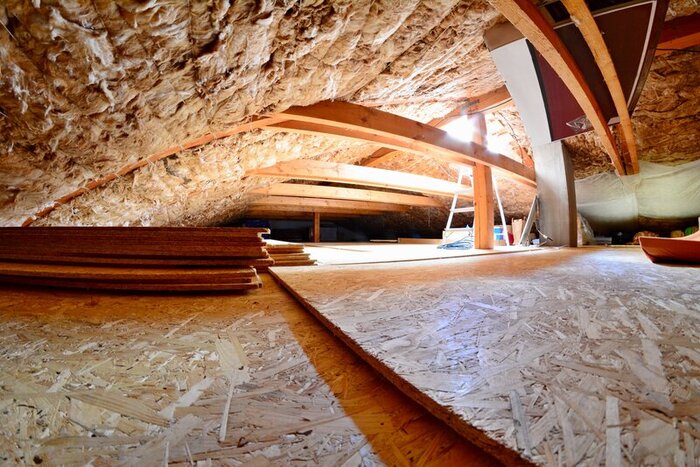
That last Bay Area heat wave signaled the final hurrah for summer. Now, the notable arrival of fall means it’s time to inspect the attic and determine whether or not your home is under insulated.
Even without a professional attic inspection, seven signs indicate a building’s insulation requires attention.
While these seven signs commonly mean your home is under insulated, they can also be a sign that insulation is damaged or destroyed by a prior roof or plumbing leaks, pest infestations, or disruptions by subcontractors who required attic access and didn’t clean up their mess.
A well-sealed and insulated home shouldn’t feel drafty at all, especially if you have relatively modern windows. Any drafts are a sign that insulation isn’t doing its job. Note where the drafts are most apparent and do some sleuthing.
If air movement is always near specific windows or doors, you may need to address caulking, sealing, and weather stripping. However, if drafts are less “focused” and are felt more by way of continuous changes in air temperature, odds are the insulation needs to be replaced or added to. If your home is 20 years old or more, and you’ve never updated your attic, we guarantee it needs attention to catch up with current energy-efficiency building codes.
Just as we recommend annual attic inspections, we also recommend annual HVAC inspections. If your HVAC is new or is regularly serviced, but it continues to cycle on or off, odds are you have an insulation situation.
The continuous cycling on/off by the HVAC system means the equipment struggles to maintain the desired thermostat setting. In addition to unnecessarily high heating/cooling costs, this also adds extra wear and tear to your HVAC system, creating added maintenance expenses.
The attic has a few helpers - including the roof, ventilation systems, and the HVAC. When these three are well-designed and maintained, whole-home humidity levels remain consistently between 30% to 40% (summer levels can go as high as 50% to 60%).
If humidity levels rise without adequate ventilation and air circulation, mold and mildew thrive. Therefore, any signs of mold or mildew (including a damp or musty smell) need attention immediately. In some cases, these signs indicate a latent roof or plumbing leak, but general mold and mildew growth indicate an underinsulated attic or crawlspace.
If you have a rodent problem in the attic, you have an insulation problem. In most cases, you’ll see evidence of shredded and torn-up insulation because it makes such wonderful nesting material. Unfortunately, in addition to nest-related destruction, the insulation becomes saturated with rodent feces and urine.
This creates an unsanitary and unhygienic environment. Over time, built-up pest debris creates unappealing odors and toxic fumes. In the meantime, dried particles circulate through the HVAC ducts, compromising indoor air quality. All of the above is bad for you and other home occupants.
Fall is a rodent’s optimal attic move-in season because your attic offers protection from the elements and perfect corners for hiding stored nuts and seeds. Read Tips For a Rodent Free Attic and take action before the cold weather sets in.
It’s not uncommon for small roof leaks to exist without notice for quite some time. It can take months or several seasons of water and moisture accumulation before becoming apparent in the livable areas of a home. In the meantime, all the repeat cycles of leak-wet-dry breakdown insulation.
If there are any signs of current or previous roof or plumbing leaks, ask your attic specialist to determine whether or not they’ve done permanent insulation damage.
We spend lots of time talking about attic insulation because the large majority of heat gain and loss happens through the attic and roof. However, exterior wall insulation is just as crucial for interior comfort.
In a well-insulated home, the walls are the same temperature as the interior rooms. If you touch the walls, they’ll just feel like a neutral temperature. Therefore, if you touch your home’s exterior walls and they are warm during the hot months and cool when it’s cold outside - you need more insulation.
Once we update the insulation in your exterior walls and attic, you’ll notice an immediate difference. Those chairs and couches by the wall will be comfortable to sit in again.
Insulation is predominantly designed to prevent heat gain and loss from the outdoor environment. However, insulation also helps to make your home quiet. If the neighbors complain about noises that don’t seem so loud to you on the inside, or you live on a busy street and can always hear traffic or passersby, you may not have enough insulation.
The combination of dual-paned windows, adequate insulation with the proper R-value for our Bay Area climate, and maintained caulking and weather stripping makes a remarkable difference in creating a more peaceful home. Even if your home has “enough” insulation according to current building codes, we can talk to you about insulation upgrades designed for soundproofing, which make for a much better night’s sleep.
Do you suspect your home is under insulated? Contact Attic Solutions (510) 500-5007, and schedule an attic inspection. We’ll know immediately whether insulation or other factors are contributing to any of the above seven signs. Then, we’ll provide an actionable plan to get you where you need to be for optimal home comfort and energy efficiency.